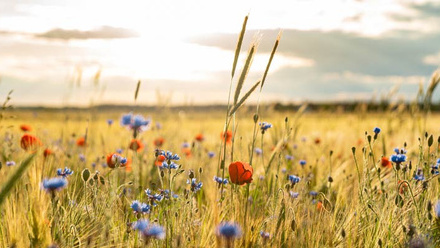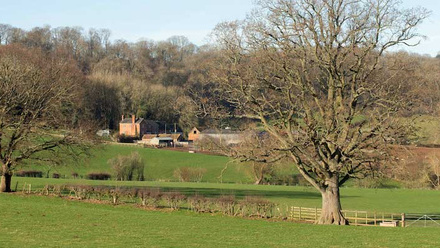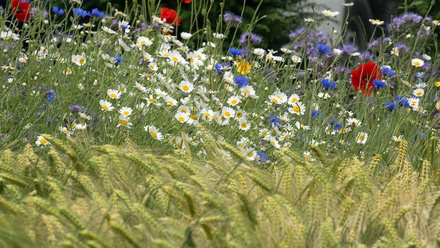ELMs Case Study: Alnwick, Northumberland
Summary
- Beef and sheep farm
- Third-generation tenant farmers
- Ram breeder
- Sophisticated data recording
- Forage-based
- Concern for the environment
- Profitable and sustainable
- Successful trial on using custom fertiliser blend to increase lamb growth
- Reduced nitrogen but increased growth
- Environment is a key driver
- Open to opportunities with ELMS
Background
This farm is a beef and sheep business run in partnership with the farmer's father and is based near Alnwick in Northumberland.
The farmer is the third generation of tenants on the land having come into the business 12 years ago. His grandfather moved
to the area around the middle of the last century.
The farm covers 220 hectares and has 1,500 sheep and 175 head of cattle including youngstock. These numbers have grown
significantly since James took over the farm with the number of sheep doubling and the cattle tripling in the same area.
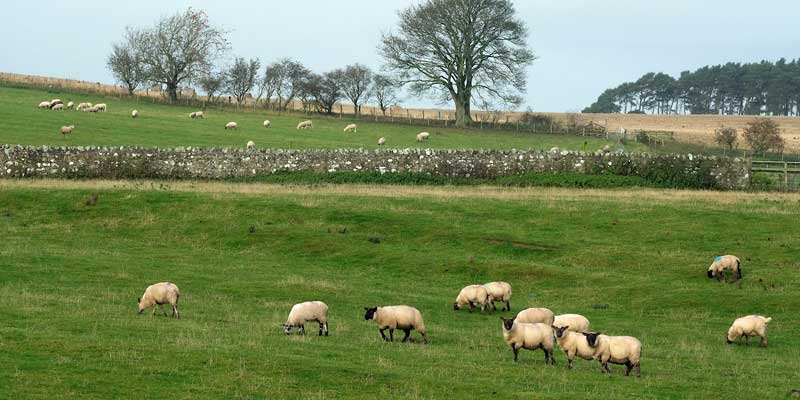
All this has been done while reducing the need for bought-in feed and making better use of grass – a system that works for this farm.
Performance recording
Unusually the farm is fully performance recorded and has been for the past eight years. As well as providing data to help management, this also makes it ideal for carrying out trials.
The farmer says: “Every single lamb on the farm is electronically tagged. We record some 21 EBVs (Estimated Breeding Values) for each lamb. It means we can track different management groups for factors such as weight gain or condition. This has become a routine part of our day-to-day practice on the farm.
“We are quite a large ram breeder for a genetics company and this is what kick-started our recording programme as everything has to be recorded for EBVs.”
He continues: “We out-winter all stock. All the cattle are outside and during the winter they will be fed using fodder beet or bale grazing. The sheep are also outside on fodder beet, the ewe lambs on a kale/swede mix and the ram lambs on an all-grass wintering system.”
Forage-focussed
“We are very forage focussed and the whole point of our recording is to analyse genetics on a forage basis, so we have to be good at growing grass, and when we can’t grow grass in the winter, be good at managing the forage crops. By analysing on a
forage basis we can look at those that perform best using EBVs.
“Environmentally that’s the way I want to go on the farm, not being reliant on housing a lot of stock and not using grain and other feedstuffs.”
Given its ability to collect data, the farm has done a lot of work looking at blood profiles, minerals and other factors involved in raising sheep. It is also involved in national and local benchmarking activity including AHDB’s Challenge Sheep project.
“We have always benchmarked our performance against other farms at the top end of the groups we are involved with,” says the farmer, “So we know we are not struggling for performance but we are always looking at ways to improve our lamb growth.
If we can run higher numbers it will make it more profitable for us, but also it’s more efficient and, using a forage-based system, more environmentally friendly.”
In terms of improving cultivation methods on the farm, the farmer has had some success in using direct drilling for his fodder beet but is also using min-till.
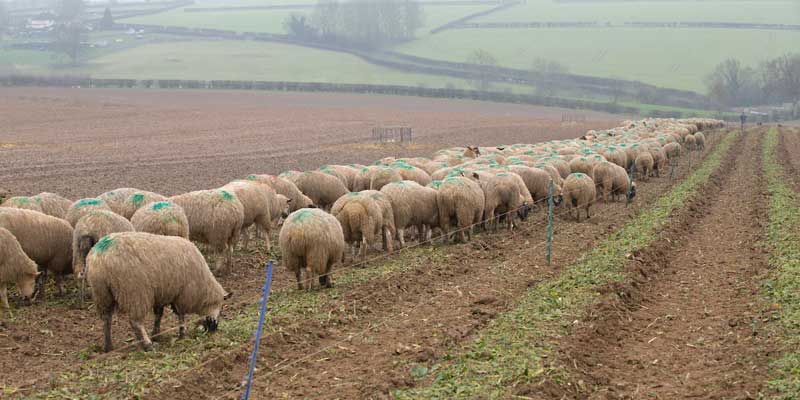
He says: “We have used direct drilling successfully in the past but last year we built a min-till cultivator and that’s what we use for all our fodder – so we don’t plough at all and we direct drill the kale/swede mix and any re-seeding on the farm.
"It’s all about enhancing the soil. Soil structure is very important, especially for the winter grazing,
so heavy cultivations do not make sense.”
Role of the advisers and network
Although the farm does not use very much fertiliser at all, what it does use is supplied by a distributor that has a supply relationship with a major fertiliser manufacturer.
The farmer uses bespoke blends on his fodder beet and kale as well as supplementing the pastures for early season boost and using fertiliser to help improve performance.
His direct relationship with the adviser of the fertiliser company came as a result of a sheep farming meeting and led to the
trial outlined below.
Other than advice on fertiliser blends, there is very little direct consultancy used by the farm. The farmer is involved with a number of groups run by AHDB and NSA (National Sheep Association) which enables him to share knowledge with other
farmers.
“We’re involved with a precision grazing group nationally,” he says, “As well as a local grazing group facilitated by a consultant. It is really sharing information with these groups that enables us to make tweaks to our processes and we don’t really see the need for any other advisers.”
Environmental activity
James emphasises that farming sympathetically with the environment is important to the business and this is one of the main drivers behind running a forage-based system.
The farm is in Mid-Tier Countryside Stewardship and this has provided the capital grants for hedging.
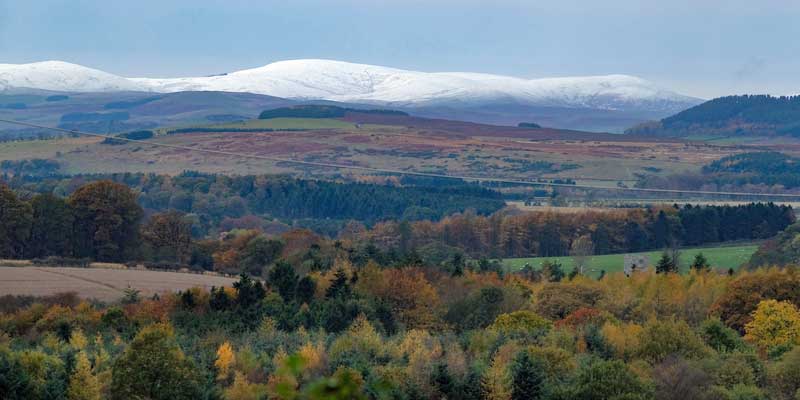
"Our forage system has a low environmental impact and helps us to reduce diesel,” he says, “We are not using
bedding straw or continually having to muck out. Also we are not traipsing around all the fields during the winter taking the
bales out.
“We grow a lot of herbal/legume leys on the farm. These provide a very deep root structure and help to build the organic matter in the soil. They also draw down carbon to a greater depth and help to access more minerals, which are obviously important for livestock performance.
“Obviously we want to reduce greenhouse gas emissions from livestock and if we can reduce days to slaughter through better growth then that contributes to making that reduction, as well as helping to increase our profitability.
“We have also planted three-and-half kilometres of hedging this year and we put in the same a couple of years ago. We have received grants from Mid-Tier for that work. We can’t put in woodland as it’s a tenanted farm, but we can plant and maintain hedges.
“We are putting in shelter belts for the stock and also building livestock corridors for the animals moving around the farm. With the herbal leys we are looking at different flowering dates to encourage insects and in general, we aim to farm in harmony with nature while being profitable.”
Grassland trial with Origin
Following an initial discussion at a meeting arranged by the fertiliser supplier, the farm has been working for the past two years on a trial to assess the effect of custom-made fertiliser blends on grass quality and lamb growth.
The trial has been run with the farm by the fertiliser supplier's Nutrition Agronomist for the North-East who is FACTS Qualified. The feriliser company has developed a NutriMatch system for producing bespoke fertilisers blends designed to meet the specific needs of the soil, grass and forage crops they are being applied to.
The company has enjoyed some success in demonstrating the effectiveness of this approach on pastureland for dairy herds but wanted to explore how this might work for sheep.
Improved performance
The nutrition agronomist says: “Many livestock producers are looking to reduce nitrogen use. We understand this and as a fertiliser producer we are well placed as we can produce bespoke products that enable farmers to reduce nitrogen inputs while increasing outputs. It is sometimes forgotten that improved productivity can also improve our environmental impact as we can achieve a lower carbon footprint per kilogram of product produced, whether that be meat, milk or grain as
opposed to cutting inputs and accepting a drop in productivity.”
The farmer agreed with this attitude in the context of the discussion groups he is involved with. “These groups are generally looking at reducing nitrogen,” he says, “But they are farmers who want to be more profitable and are looking to improve performance and, therefore, reduce environmental impact. They are willing to spend more money on improving their soil nutrient balance through bespoke blends like those that the fertiliser company produce.”
In the first year of the trial the company compared the results from straight nitrogen applications with its nitrogen/sodium mix and found that the mix increased lamb growth by 17.6 per cent. In the second year a more ‘customised’ approach was employed beginning with soil sampling the field used for the trial.
As a result a unique blend of nitrogen, phosphorus, sulphur, sodium, selenium, molybdenum, zinc and manganese was produced which matched the crop needs and deficiencies within the soil. The performance of this was compared to ammonium nitrate (nitrogen fertiliser only) applied across the other half of the field.
Reducing nitrogen
The nutrionist says: “One of the important things which we wanted to do was to reduce the nitrogen content in the custom blend to assess its effect. In terms of kilograms per hectare it contained 101 kg/ha of nitrogen compared to the off the shelf product at 120 kg/ha – a 15 per cent reduction. We wanted to see if we could maintain lamb performance while reducing nitrogen application.”
The trial was conducted on one 8.4 ha field split between the two different applications. There were 54 ewes with twin lambs on each side of the field. Lamb weights were collected at birth, eight weeks and weaning. Grass cover was measured weekly and forage analysis for mineral content and quality was carried out fortnightly.
All minerals (not just those in the blend) apart from manganese increased in the forage on the side with custom blend applied and, despite the 15% decrease in the nitrogen, the amount of nitrogen in the forage increased by a third. There was also a significant increase in grass cover on the side treated with the custom blend.
20% plus increase
The critical measurement for the trial was weight gained since birth. This showed that the average weight gained per head on the custom blend was 35.37 kg compared to 29.40, an increase of 20.3%.
Both the nutritionist and the farmer point out that better production performance also reduces the environmental impact for each lamb raised. In terms of return on investment, at the time of the trial an additional investment of £67.52 per hectare returned an additional output of £328.35/ha, a difference of £260.83.
This amounted to £4.86 for every £1 invested. The other nutrients and micro-nutrients applied as part of the trial will also have a long-term effect on the quality
of the soil.
The carbon footprint for the fertiliser showed a reduction from 0.47 kg CO2 for the ammonium nitrate compared to 0.37 kg for the customised blend – a
21.3% reduction.
The farmer says: “We really don’t use a lot of nitrogen on our farm anyway, but there are many farms relying on high levels of nitrogen and I can see that the use of these type of blends with a complete range of nutrients required could lower the carbon footprint of the fertiliser purchased, and improve nitrogen use efficiency. This in turn gives us a lower carbon footprint per Kg of meat from a better farm nutrient balance.
“There are obviously tremendous benefits and we will certainly carry out further trials on farm. If it can increase the quality of our lambs, then it can add value across everything we do.”
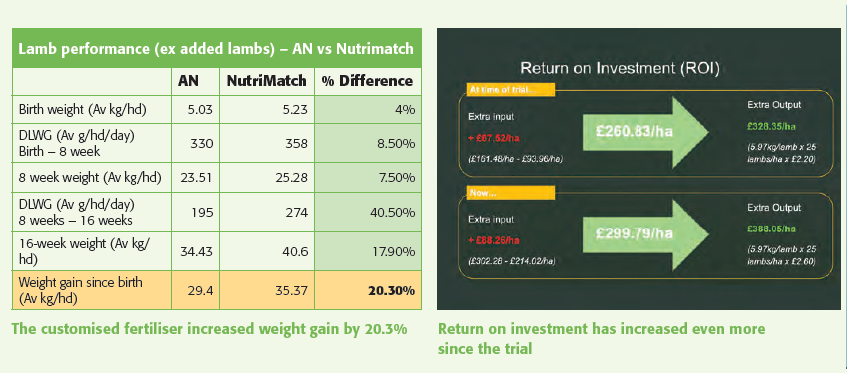
Attitude towards environmental stewardship and ELMS
The farmer is currently in Mid-Tier Countryside Stewardship and is waiting to see how ELMS will affect the farm.
"To start with,” he says, “We want to be farming in a way that is as environmentally friendly as possible. We could probably double output again if we wanted to increase inputs, but that’s not a route I want to go down. We want to be as productive as we can from a forage-based system that enables me to be profitable without payments.
“Then we will look at what payments are available that will work alongside what we do. We have used Mid-Tier for a lot of capital payments, particularly for hedges and if it works in a similar way, we are happy to work with it. I’m not chasing the highest-paying options otherwise, we could be putting the whole of the farm over to wild bird mixes.
“However, there are areas on the farm where these options could work, and there are things we do already that we could get rewarded for, especially as a result of better soil and nutrient management planning to continually improve efficiencies and the associated environmental goods resulting from our efforts.
"Get nutrient management right, then there are benefits in every direction, for soil quality, water quality, biodiversity, net zero and farm profit. Also, there are areas on the farm where we use minimal inputs and these parts could be eligible.
“I did a trial for ELMS with ADAS twelve months ago and I thought the options that they were looking at such as direct drilling, made a lot of sense. I think a lot of farmers do need pushing in the right direction. They have been paid just for farming but need an incentive to move towards more sustainable practices.”
Potential areas for ELMS
Potential areas that this farm could be involved with in ELMS include:
- Soil management
- Boundary features (Creating and managing hedges)
- Nutrient management
- Grazing infrastructure
- Stocking density and grazing location
- Managing field edges


